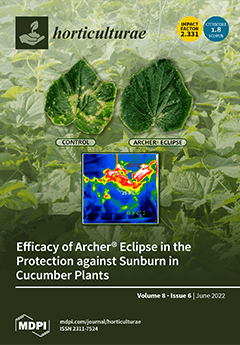Physiological responses of different interspecific
Pyrus hybrids and an open pollinated
Pyrus communis ‘Williams’ (Pcw) grown under
in vitro culture conditions simulating lime induced chlorosis were studied. The hybrids were derived from crosses between the ‘Pyriam’ pear rootstock and four
Pyrus species of
[...] Read more.
Physiological responses of different interspecific
Pyrus hybrids and an open pollinated
Pyrus communis ‘Williams’ (Pcw) grown under
in vitro culture conditions simulating lime induced chlorosis were studied. The hybrids were derived from crosses between the ‘Pyriam’ pear rootstock and four
Pyrus species of the Mediterranean region, namely
P. amygdaliformis Vill. (Pa),
P. amygdaliformis persica Bornme. (Pap),
P. communis cordata (Desv.) Hook. (Pcc), and
P. elaeagrifolia Pall (Pe), all known for their higher field tolerance to iron-chlorosis than
P. communis. Twenty hybrids and one open pollinated Pcw were micropropagated, and plantlets were
in vitro characterized for their physiological responses to iron-deficiency conditions. Rooted plantlets were transferred to a culture medium with 2 µM Fe
3+ DTPA and 10 or 20 mM NaHCO
3. These physiological responses were scored at 1, 3, 7, and 28 days from the start of the
in vitro assay. Leaf total chlorophyll content, the capacity of roots to acidify the medium, reduced iron, and exudates of phenolic acids and organic acids were analyzed in each media and time sample. Leaf chlorophyll levels for the clones derived from Pcc were the highest, especially under the highest bicarbonate concentration, followed by those derived from Pap and Pa. The higher chlorophyll content of Pcc clones were related with their higher capacity to acidify the media but not with their iron reduction capacity at the root level. On the other hand, hybrid clones derived from Pe showed a higher Fe
3+ reduction ability than clones from all the other species during the whole assay but only when the bicarbonate concentration was lower. The exudation of phenolic acids by the roots was higher in Pcw than in the other species, and this response might explain why the total chlorophyll levels in Pcw clones are similar to those of Pe and Pa ones. These results with
Pyrus spp. bring more evidence in support of the idea that iron reduction capacity at the root level is not directly related with a higher tolerance to iron deficiency caused by the high pH of calcareous soils. Instead, the ability to acidify the rhizosphere is the trait of choice for the selection of the pear hybrid clones better adapted to lime induced chlorosis. In addition, the
in vitro assay to select the
Pyrus clones for tolerance to iron chlorosis could be shortened to one week of culture in 10 mM NaHCO
3, measuring the leaf chlorophyll level, acidification of the culture medium, and exudation of phenolic acids as the physiological responses to predict tolerance to lime-induced chlorosis.
Full article





